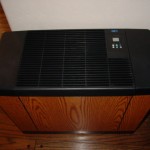A common complaint about hardwood floors in arid zones is checking and splitting due to low humidity. Many people believe running a humidifier in arid zones in summer is futile. This is largely due to the fact that an AC unit is a de-humidifier. These will counter act each other but not totally as your AC does not run continually and this counter reaction by the AC unit can be neutralized to a point with a stand alone humidifier. However, some checking should be expected in your wood flooring if the relative humidity gets to low as nothing can be 100% effective. I see more and more manufacturers putting these relative humidity requirements in ink. Even right on the outside of the boxes.
The old school of thought was to acclimate the wood out in the open and either dry it down to your zone (4 to 8% in my area) or let the wood gain moisture and equilibrate with the surroundings. Be it known this zone map is for exterior relative humidity levels. Typically interior relative humidity levels run higher inside a home. What you want to do is have the temp and relative humidity at the median levels of the yearly highs and lows. If you have an installer who does not check the relative humidity with a thermo -hygrometer and moisture content of wood sub-floors and the wood then you may want to look elsewhere for a qualified installer.
Now this is old school of thought is changing, and now your expected to bring your homes interior ambient relative humidity and temp to the woods comfort zone, especially with the pre-finished flooring so the wood is in a stable environment and the hard finish will not check, and the wood is less likely to split.
Hardwood when milled are kiln dried down to anywhere from 6% to 9% moisture content. Looking at the Forest Products Laboratory’s Equilibrium Moisture Content Chart, we see that if the interior temp and relative humidity is kept between 30 to 45% rh and 60 to 80 degrees F, your hardwood floors moisture content will run from 6.1 to 8.6%, which I believe is a pretty good median range for arid zones. I tend to shoot for 7’s.
In my zone anyway (Southern Arizona) it is still very dry during the summer months down into the single digits until the rains (monsoons) come in mid July to August. Even though one may think it is useless, a humidifying system attached to your HVAC system is still working to keep up the relative humidity in your home, lessoning the chance your hardwood floor will check and split.
Let it be known the checks and some splits are actually already there depending on the kiln drying and type of manufacturing ie; rotary (especially so), sliced or sawn face. The idea is to keep them from becoming visible and showing up to the naked eye. Under no circumstances should your engineered wood delaminate strictly because of low relative humidity.
Using a stand alone humidifier and/or with the one in installed with your HVAC system,or even two or three stand alone humidifiers depending on the size of your house may be needed. Speak with a qualified HVAC salesman. I have a stand alone
that will cover 2,000 square feet and keeps my house at 30% relative humidity very easily without running every ten minutes. Once the unit runs for awhile and the home is acclimated it is relatively easy for it to stay in the upper 30+ % range.
Also, quite a few houses like mine have dual cooling systems. I am able to run an evaporative cooling system (Master Cool II) which easily raises the relative humidity of the home to any manufactures requirements and in some cases to much. Many contractors will not install hardwood in homes exclusively cooled with an evaporative cooling system and the floor expand to much. I have large wooden beam and exposed ceiling timbers and when I crank on the evaporative cooler, you can hear creaks and noises of the wood expanding. This not a great way to introduce moisture into the air as it is much to fast, especially for existing floors. So since I brought my humidifier into the equation, the floor is not shocked as badly as when I first got the home several years ago.When the rainy season comes it is imperative to have a thermo hygrometer to know when to switch to AC.
Humidification of your house in arid zones like Arizona will also help your wood furniture as well as your sinuses. In fact, it is very healthy and typically called a comfort zone, which runs anywhere between 30 to 55 %, yes, just like humans. The exception may be in some zones where the higher amount of humidity can cause condensation on windows and even promote mold growth.
I had an interesting job several years ago where I installed a solid maple floor in a piano dealers new building. He humidifiers his entire store, winter through summer. In fact he freaked out when I was installing some solid maple in his showroom because I left the door open when transporting tools in and out. His $100,000 Steinway he had near the entrance needs a constant ambient temp and relative humidity or the wood will__________ , you fill in the blank.
Needless to say I don’t have to worry about that maple flooring. There really is no excuse for not maintaining your hardwood floor close to manufactures ambient zone requirements. Hardwood flooring is a large investment, take care of it properly.
